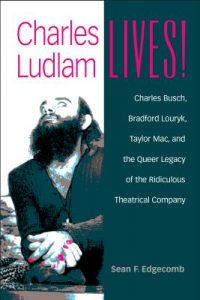 Charles Ludlam Lives! Charles Busch, Bradford Louryk, Taylor Mac, and the Queer Legacy of the Ridiculous Theatre Company
Charles Ludlam Lives! Charles Busch, Bradford Louryk, Taylor Mac, and the Queer Legacy of the Ridiculous Theatre Company
by Sean F. Edgecomb
Michigan. 246 pages, $70.
FOR THOSE who liked Charles Ludlam’s Ridiculous Theatre Company in its heyday in the 1960s, what can one say? There was a lot to like. It was a theater of true excess; sitting in the front row was ill-advised. Morphing out of the Play-House of the Ridiculous, a Manhattan-based alternative theater troupe—which was founded by the late actor-director John Vaccaro and which Ludlam joined early on—the Ridiculous Theatre Company allowed Ludlam free rein to write, perform in, and direct a series of dazzling, perverse, non-naturalistic comic pieces. His intent was to counter the humorless accounts of gay men’s marginal, miserable lives that had dominated American theater (Tennessee Williams, William Inge)—to the extent that these lives had been represented at all.
Ludlam and his fellow performers used cross-gendered performance, otherwise known as drag, to accompany cryptic and intellectually extraordinary dramatic rewrites of canonical theatrical staples as well as stories known in other forms. Turds in Hell (1967) was a remake of The Satyricon, while Bluebeard (1970) riffed on H. G. Wells’ The Island of Dr. Moreau and the legend of Bluebeard’s castle in general. Stage Blood (1975) mocked Hamlet, and The Mystery of Irma Vep (1984), Ludlam’s masterpiece, took on the “penny dreadful”—the 19th-century British equivalent of pulp fiction—as well as Victorian melodrama more widely, such as Emily Bronte’s Wuthering Heights or Daphne du Maurier’s Rebecca.
David Kaufman’s wonderful biography Ridiculous!: The Theatrical Life and Times of Charles Ludlam (2002) was unfairly critiqued by some reviewers for failing to offer any account of the “afterlife” of Ludlam’s career, which was itself ridiculously terminated by AIDS at the age of 44, in 1987. Now the very talented theater scholar Sean Edgecomb has come up with the goods, focusing on three key practitioners of “neo-Ridiculous” technique.
 They are scarcely household names if you live outside of New York, with the possible exception of Charles Busch, who, along with Everett Quinton, has done more than anyone to keep Ludlam’s works on the stage. Busch moved into film with Psycho Beach Party (2000) and had a big Broadway success that same year with The Tale of the Allergist’s Wife. It is with considerable care and thoughtfulness that Edgecomb has researched the work of Busch, as well as that of Bradford Louryk and Taylor Mac, who have built on Ludlam’s genius. Ludlam, in turn, was inspired above all by the English modernist author Ronald Firbank, whom Edgecomb does not mention. He does, however, interview many of the key players in the Ridiculous story.
They are scarcely household names if you live outside of New York, with the possible exception of Charles Busch, who, along with Everett Quinton, has done more than anyone to keep Ludlam’s works on the stage. Busch moved into film with Psycho Beach Party (2000) and had a big Broadway success that same year with The Tale of the Allergist’s Wife. It is with considerable care and thoughtfulness that Edgecomb has researched the work of Busch, as well as that of Bradford Louryk and Taylor Mac, who have built on Ludlam’s genius. Ludlam, in turn, was inspired above all by the English modernist author Ronald Firbank, whom Edgecomb does not mention. He does, however, interview many of the key players in the Ridiculous story.
My only regret is that Edgecomb mentions only twice, in passing, a fourth fellow-traveler, Lypsinka, who now performs under his own name in shows such as John Epperson: The Artist Principally Known As Lypsinka, and who clearly belongs among those who have developed Ludlam’s legacy. Nevertheless, Charles Ludlam Lives! is an important addition to American queer theater studies, to go on my shelf beside Laurence Senelick’s The Changing Room: Sex, Drag and Theatre (2000) and David Román’s Acts of Intervention: Performance, Gay Culture and AIDS (1998).
Richard Canning’s latest book is an edition of English novelist Ronald Firbank’s Vainglory (Penguin Classics).





